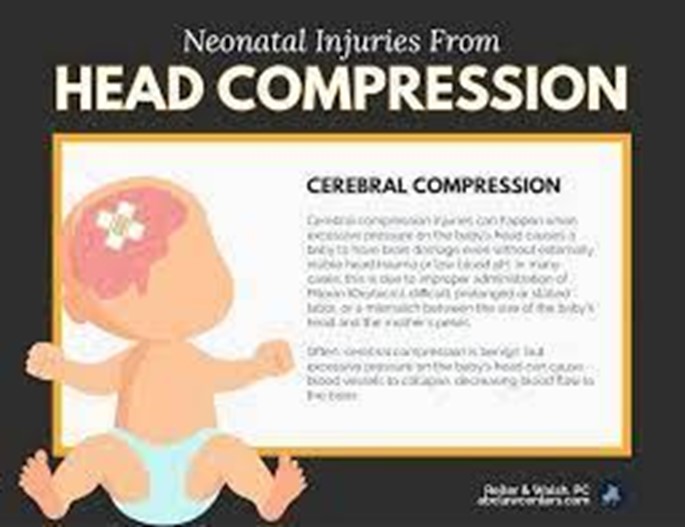A nurse is caring for a client who is in active labor. The nurse notes early decelerations of the FHR on the fetal monitor tracing. The nurse should identify that which of the following conditions causes early decelerations in the FHR?
Fetal hypoxemia.
Cord compression.
Uteroplacental insufficiency.
Head compression.
The Correct Answer is D
Choice A rationale:
Fetal hypoxemia is associated with late decelerations in the fetal heart rate (FHR) tracing. It occurs when the fetus experiences a decreased supply of oxygen, typically due to placental insufficiency or maternal hypotension.
Choice B rationale:
Cord compression can lead to variable decelerations in the FHR tracing. It occurs when the umbilical cord is compressed, restricting blood flow to the fetus temporarily.
Choice C rationale:
Uteroplacental insufficiency causes late decelerations in the FHR tracing. It refers to an inadequate blood flow between the uterus and placenta, resulting in reduced oxygen supply to the fetus.
Choice D rationale:

Head compression is the correct answer for early decelerations in the FHR tracing. It happens during contractions when the fetal head is compressed by the maternal pelvis, leading to a temporary vagal response that slows the heart rate.
Nursing Test Bank
Naxlex Comprehensive Predictor Exams
Related Questions
Correct Answer is A
Explanation
Choice A rationale:
The nurse should discontinue the oxytocin infusion if the client's contraction frequency is every 3 minutes. Frequent contractions may lead to uterine hyperstimulation, which can reduce fetal blood flow and oxygenation, potentially causing fetal distress. Normal contraction frequency during labor is typically every 2 to 5 minutes.
Choice B rationale:
Contraction duration of 100 seconds is not an indication to discontinue the oxytocin infusion. The duration of contractions can vary during labor, and 100 seconds is within the normal range of contraction duration, which is usually 45 to 90 seconds.
Choice C rationale:
Fetal heart rate with moderate variability is not an indication to discontinue the oxytocin infusion. Moderate variability in fetal heart rate is a reassuring sign, indicating a healthy fetal response to labor. It shows that the fetus is tolerating the contractions well and is not experiencing fetal distress.
Choice D rationale:
A fetal heart rate of 118/min is not an indication to discontinue the oxytocin infusion. The normal fetal heart rate range is typically between 110 to 160 beats per minute, and a heart rate of 118/min falls within this normal range. However, if the fetal heart rate deviates significantly from the normal range or shows signs of distress, further assessment and intervention are required.
Correct Answer is A
Explanation
Choice A rationale:
Rh incompatibility occurs when an Rh-negative client is exposed to Rh-positive fetal blood, typically during a prior pregnancy or delivery. The client’s immune system produces anti-Rh antibodies that cross the placenta in subsequent pregnancies, attacking the Rh-positive red blood cells of the fetus. This hemolysis releases bilirubin, leading to hyperbilirubinemia in the newborn.
Choice B rationale:
Rh incompatibility only occurs when the client is Rh-negative and the fetus is Rh-positive. An Rh-positive client will not form antibodies against an Rh-negative fetus, as their immune system recognizes the Rh factor as normal.
Choice C rationale:
This choice is not related to the mechanism of Rh incompatibility. Receiving a transfusion with Rh-negative blood would not cause the mother's immune system to produce anti-Rh antibodies or lead to Rh incompatibility with her newborn.
Choice D rationale:
This choice describes the ABO blood group system, not the Rh factor. ABO incompatibility can occur when a mother with blood type O (producing anti-A and anti-B antibodies) has a newborn with blood type A, B, or AB, leading to hemolysis of the fetal red blood cells. However, the question specifically mentions Rh incompatibility, which involves the Rh factor, not the ABO system.
Whether you are a student looking to ace your exams or a practicing nurse seeking to enhance your expertise , our nursing education contents will empower you with the confidence and competence to make a difference in the lives of patients and become a respected leader in the healthcare field.
Visit Naxlex, invest in your future and unlock endless possibilities with our unparalleled nursing education contents today
Report Wrong Answer on the Current Question
Do you disagree with the answer? If yes, what is your expected answer? Explain.
Kindly be descriptive with the issue you are facing.
